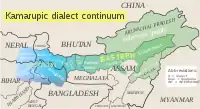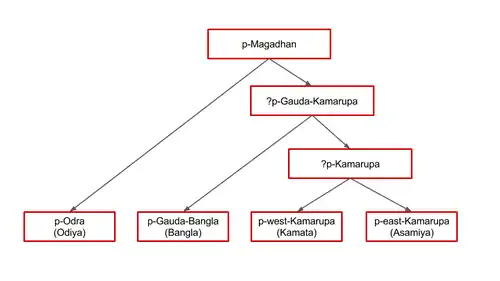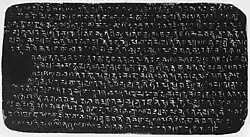Kamarupi Prakrit
Kamarupi Prakrit[1] is the postulated Middle Indo-Aryan (MIA) Prakrit language used in ancient Kamarupa (5th–13th century). This language is the historical ancestor of the Kamatapuri lects and the modern Assamese language;[2][3] and can be dated prior to 1250 CE, when the proto-Kamta language, the parent of the Kamatapuri lects, began to develop.[4] Though not substantially proven, the existence of the language that predated the Kamatapuri lects and modern Assamese is widely believed to be descended from it.[5]
| Kamarupi Prakrit | |
|---|---|
| Kamrupi Apabhramsa | |
 | |
| Pronunciation | Kāmarūpī Prākrit |
| Region | Kamarupa |
| Era | First millennium |
Indo-European
| |
Early form | |
| Kamarupi script | |
| Language codes | |
| ISO 639-3 | – |
| Glottolog | None |
| Coordinates: 26.15°N 90.81°E | |
The evidence of this MIA exist in systematic errors in the Sanskrit language used in the Kamarupa inscriptions.[6] A distinguishing characteristic of Kamarupa inscriptions is the replacement of ś and ṣ by s, which is contrary to Vararuci's rule, the main characteristic of Magadhi Prakrit, which warrants that ṣ and s are replaced by ś.[7] Linguists claim this apabhramsa gave rise to various eastern Indo-European languages like modern Assamese and felt its presence in the form of Kamrupi and Kamatapuri lects.[8][9]
Etymology of various names
The speech is known by different names, which generally consists of two words — prefix such as 'Kamrupi', 'Kamarupi', 'Kamarupa' referring to Kamarupa and suffixes 'dialect', 'Apabhramsa', sometimes 'Prakrit'. Suniti Kumar Chatterji named it as Kamarupa dialect (the dialect of Magadhi) as spoken in Kamarupa.[10] Sukumar Sen and others calls it as old Kamrupi dialect;[11][12][13] the speech used in old Kamrup[11] Some scholars termed it as Kamrupi Apabhramsa,[14] Kamarupi language or proto-Kamrupa.[2]
Characteristics

Though the epigraphs were written in classical Sanskrit in kavya style of a high degree, they abound in forms varying from the standard.[16]
- Loss of repha and reduplication of the remaining concerned consonants.
- Shortening of vowels.
- Lengthening of vowels.
- Substitution of one vowel for another.
- Avoidance and irregularity of sandhis.
- Loss of initial vowel.
- Substitution of Y by i.
- Total loss of medial Y.
- Reduplication of consonants immediately followed by r.
- Absence of duplication where it is otherwise necessary.
- Varieties of assimilation.
- Wrong analogy.
- Varied substitution for m and final m.
- Substitution of h by gh and substitution of bh by h.
- Indiscriminate substitution of one sibilant for another.
- Irregularity of declension in case of stems ending in consonants.
- Absence of visarga even where it is invariably necessary.
Apabhramsa

Some linguists claim that there existed a Kamrupi apabhramsa as opposed to the Magadhi apabhramsa from which the three cognate languages---Assamese, Bengali and Odia and Maithili---sprouted. The initial motive comes from extra-linguistic considerations. Kamarupa was the most powerful and formidable kingdom in the region which provided the political and cultural influence for the development of the Kamrupi apabhramsa.
Xuanzang (or Hiuen Tsang), when he visited Kamarupa in 643 CE mentioned that the language spoken in Kamarupa was a 'little different' from the one spoken in mid-India is provided as evidence[17] that this apabhramsa existed as early as the 5th century.
Geographical vicinity
Assamese, or more appropriately the old Kamarupi dialect entered into Kamrup or western Assam, where this speech was first characterized as Assamese.[11]
Golockchandra Goswami in his An introduction to Assamese phonology writes, "in early Assamese there seems to be one dominant dialect prevailing over the whole country, the Western Assamese dialect." Similarly Upendranath Goswami says, "Assamese entered into Kamarupa or western Assam where this speech was first characterised as Assamese. This is evident from the remarks of Hiuen Tsang who visited the Kingdom of Kamarupa in the first half of the seventh century A.D., during the reign of Bhaskaravarman"
Works
The sample of the old Kamrupi dialect are found in different inscriptions scattered around eastern and northern India, such as Bhaskar Varman's inscriptions. Daka, a native of Lehidangara village of Barpeta composed an authoritative work named Dakabhanita in the 8th century A.D.[12]
See also
References
- "On the basis of many such evidences it is claimed that the Assamese language developed not from the Magadhi but from another parallel variety of Prakrit, which deserves to be called the Kamarupi Prakrit." (Sharma 1978, p. xxv)
- "In this study I refer to the western dialect of Asamiya as Kamrupi, and the historical ancestor of proto-Kamata and proto-Asamiya as proto-Kamrupa." (Toulmin 2006, p. 14)
- "Eastern Magadhi Prakrit has been divided into four dialect groups by scholars like Dr Chatterji. Kamarupa dialect comprising Assamese and the dialects of North Bengal is one of them. So it becomes necessary to see how much Kamrupi is related to North Bengali" (Goswami 1970, p. 177)
- "On sociliohistorical grounds, this stage is termed 'proto-Kamta' and assigned the chronological period c1250-1550..." (Toulmin 2006, p. 8)
- "The Kamta-Asamiya sub-grouping hypothesis was probably first articulated by Grierson (1903). At this point Chaterji (1926) and Kakati (1962) concur with Grierson's diagnosis and the same position is reflected in recent statements like that of Baruah and Masica (2001)." (Toulmin 2006:295)
- "... (it shows) that in Ancient Assam there were three languages viz. (1) Sanskrit as the official language and the language of the learned few, (2) Non-Aryan tribal languages of the Austric and Tibeto-Burman families, and (3) a local variety of Prakrit (ie a MIA) wherefrom, in course of time, the modern Assamese language as a MIL, emerged." (Sharma 1978, pp. 0.24–0.28)
- "The replacement of ṣ and s by ś is one of the main characteristics of the Magadha Prakrit, as warranted by Vararuci's rule, ṣasau śah. But in the Kamarupa inscriptions, we find the reverse of it, i.e the replacement of ś by s as in the word suhańkara, substituted for the Sanskrit śubhańkara in line 32 of the Subhankarpataka grant of Dharmapala." This contrary rule was first pointed out by Dimbeswar Neog (Sharma 1978, p. 0.25), (link)
- Mrinal Miri, Linguistic situation in North-East India , 2003, Scholars have shown that it is rather through the western Assam dialects that the development of modern Assamese has to be traced.
- Sukhabilasa Barma, Bhawaiya, ethnomusicological study,2004 Based on the materials of the Linguistic Survey of India, Suniti Kumar Chattopadhyay has divided Eastern Magadhi Prakrit and Apabhramsa into four dialect groups (1) Radha-the language of West Bengal and Orissa (2) Varendra-dialect of North Central Bengal (3) Kamrupi-dialect of Northern Bengal and Assam and (4) Vanga-dialect of East Bengal.
- Suniti Kumar Chatterji,The origin and development of the Bengali language, Volume 1, One would expect one and identical language to have been current in North Central Bengal (Pundra-vardhana) and North Bengal and West Assam (Kamarupa) in the 7th century, since these tracts, and other parts of Bengal, had almost the same speech.
- Sukumar Sen, Grammatical sketches of Indian languages with comparative vocabulary and texts, Volume 1, 1975, P 31, Assamese, or more appropriately the old Kamarupi dialect entered into Kamrup or western Assam, where this speech was first characterized as Assamese.
- Choudhary, Abhay Kant (1971), Early Medieval Village in North-eastern India, A.D. 600-1200:Mainly a Socio-economic Study, Punthi Pustak (India), page 253, pages 411 Daka is stated to have belonged to village Lehidangara near Barpeta in the district of Kamrup, and the Dakabhanita, a work in the old Kamarupi dialect, said to have been composed about the 8th century A D.
- Rabindra Panth (2004), Buddhism and Culture of North-East India, p.8, p.p 152 it bears a close resemblance to modern Assamese language, the direct offspring of the old Kamarupi dialect.
- "This sort of oneness must have helped the growth of a common language which can be termed as Kamrupi Prakrit or Kamrupi Apabhramsa" (Hazarika 1968, p. 80)
- Proto-Kamta took its inheritance from ?proto-Kamrupa (and before that from ?proto-Gauda-Kamrupa), innovated the unique features ... in 1250-1550 AD" (Toulmin 2006:306)
- (Sharma 1978, p. 024)
- "It is curious to find that according to (Hiuen Tsang) the language of Kamarupa 'differed a little' from that of mid-India. Hiuen Tsang is silent about the language of Pundra-vardhana or Karna-Suvarna; it can be presumed that the language of these tracts was identical with that of Magadha." (Chatterji 1926, p. 78)
Bibliography
- Chatterji (1926). The Origin and Development of the Bengali Language.
- Hazarika, Parikshit (1968). "The Kamarupi Apabhramsa". Journal of the Assam Research Society. 18: 77–85.
- Goswami, Upendra Nath (1970). A study on Kāmrūpī: a dialect of Assamese. Dept. of Historical Antiquarian Studies, Assam.
- Sharma, Mukunda Madhava (1978). Inscriptions of Ancient Assam. Guwahati, Assam: Gauhati University.
- Toulmin, Mathew W S (2006). Reconstructing linguistic history in a dialect continuum: The Kamta, Rajbanshi, and Northern Deshi Bangla subgroup of Indo-Aryan (Ph.D.). The Australian National University.